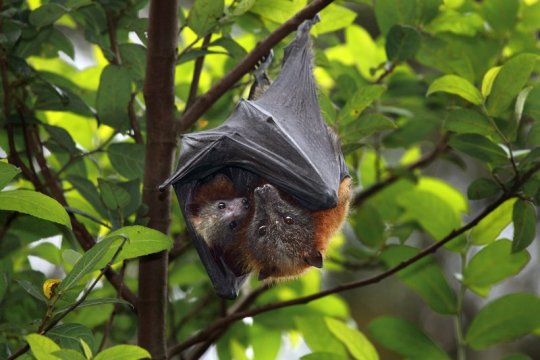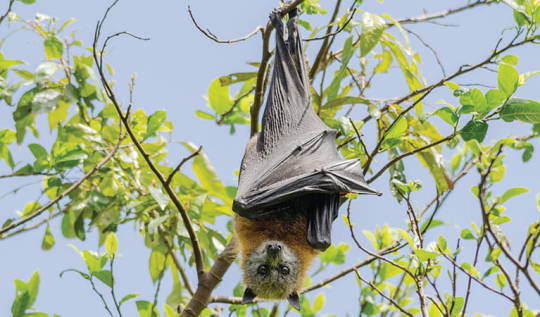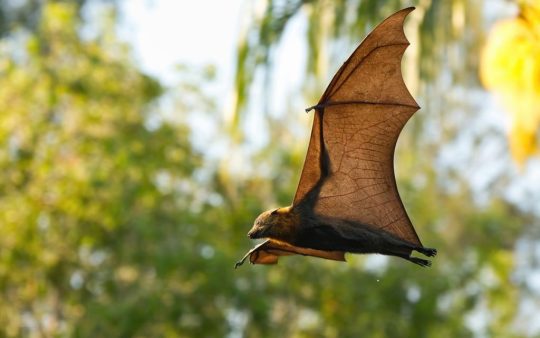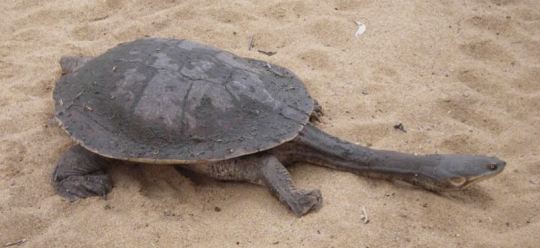#East Australia
Explore tagged Tumblr posts
Text



Get Foxy with the Grey-headed Flying Fox
Pteropus poliocephalus, better known as grey-headed flying foxes, are a species of megabat native to eastern Australia. They are typically found in rainforests, woodlands, and swamps, but they have also become common in more agricultural and urban areas, particularly those that maintain large groves of trees. They are semi-migratory, moving when food availability diminishes, and can travel over 1000 km (620 mi) over the course of a season.
Like most bats, grey-headed flying foxes forage at night. They feed exclusively on fruit, pollen, nectar, and tree bark-- most commonly from figs and two species of eucalyptus tree-- and may fly up to 50 km (31 mi) in a single night to find food. Although they are quite large, P. poliocephalus can fall prey to eagles, goannas and snakes, particularly as pups or juveniles.
Because they do not feed on insects, these bats do not use echolocation to navigate. Instead, they use a large range of calls to communicate with other members of their colony, which can contain several hundred members in the summer. Winter colonies are slightly smaller, and segregated by sex, but individuals and families within these groups will stay together for several generations.
Mating occurs between March and May, when males stake out territories and compete to attract females. After mating, mothers seclude themselves in a female-only colony and gestate a singe pup about 6 months after breeding. Weaning takes an additional 5-6 months, after which juveniles separate from their mother. Daughters typically stay within their mother's winter colony, while sons join the male colony after a year's time. Individuals take approximately 30 months to become fully mature, and may live up to 10 years in the wild.
The grey-headed flying fox is notable for being the largest of Australia's bat species. Adults can be anywhere from 600-1000 g (21.5- 35.2 oz), with a wingspan of up to 1 m (3.3 ft). As their name implies, the body is covered with burnt orange fur, and the face is large and fox-like, with none of the large ears or distinct nasal apparatuses that distinguish other bat species.
Conservation status: P. poliocephalus is considered Vulnerable by the IUCN. Populations are declining largely due to habitat destruction. Many individuals are also killed by farmers, who consider them to be pests.
Photos
Vivien Jones
Shane Ruming
Andrew Mercer
#grey-headed flying fox#Chiroptera#Pteropodidae#fruit bats#flying foxes#bats#mammals#tropical forests#tropical forest mammals#tropical rainforests#tropical rainforest mammals#deciduous forests#deciduous forest mammals#urban fauna#urban mammals#oceania#australia#east australia#biology#zoology#ecology#animal facts
82 notes
·
View notes
Text

Guadalajara, Mexico @antifastreet
#Guadalajara#Mexico#art#street art#graffiti#viva palestina#viva palestina libre#palestine#gaza#rafah#free palestine#freepalastine🇵🇸#middle east#lebanon#lebanese#free lebanon#ausgov#politas#auspol#tasgov#taspol#australia#fuck neoliberals#neoliberal capitalism#anthony albanese#albanese government#save palestine#palestinian genocide#i stand with palestine#all eyes on palestine
2K notes
·
View notes
Text

east coast woes (one day apart)
#my art#oily tag#australia east coast btw though i suppose its applicable everywhere#on account of the horrors
3K notes
·
View notes
Video
youtube
Australian doctor reveals what it's like in Gaza as UN backs ceasefire
Warning: he gets graphic.
Would mainstream USA news ever let this air?
#youtube#tw war crimes#australia#doctors#israel#free palestine#poc#palestine#gaza#doctors without borders#liberals#nurses#cnn#fox news#middle east#msnbc#gaza genocide#ceasfire now#united kingdom
659 notes
·
View notes
Text

Matagarup Bridge, Perth, Western Australia: Matagarup Bridge is a suspension pedestrian bridge crossing over the Swan River in Perth, Western Australia. Situated approximately half-way between Heirisson Island and the Goongoongup Bridge, it provides pedestrian access between Burswood and East Perth. The bridge connects visitors to the Burswood Peninsula, including the Perth Stadium, with public transport and car parks in East Perth and the Perth central business district. Wikipedia
#Matagarup Bridge#Pedestrian and cycle traffic#Swan River#Perth#Nile St#East Perth#Western Australia#Australia#oceania#oceania continent
164 notes
·
View notes
Text
Synagogues being burned down is becoming common .
instagram
If it was a mosque or a church, this would be trending
#Australia#israel#jewish#israeli#jewblr#israel palestine conflict#gaza strip#ישראל#טאמבלר ישראלי#hamas is isis#middle east#Gaza#jumblr#עברית#Instagram
183 notes
·
View notes
Text

Wolai Avenue, Bentleigh East (Melbourne), Victoria.
98 notes
·
View notes
Text

A family camping in East Alligator River
Kakadu National Park
1977
#vintage camping#campfire light#australia#kakadu national park#east alligator river#family camping#camping#history#1970s
155 notes
·
View notes
Text

Welcome 2025!
Dusky Sea Snake (Aipysurus fuscus) AKA Timor Reef Snake
Timor Sea between Australia and Indonesia
Status: Endangered
#happy new year#happy 2025#snake#year of the snake#snake art#new year art#reptile#endangered species#animal art#australia#indonesia#east timor
47 notes
·
View notes
Text
open tumblr post to make miserable statement about stress, mental health, anxiety, trying to survive in the world etc etc
grit teeth and close post because have to have hope
stress remains and gets worse
open post
close without posting
repeat ad nauseam
#do you know the whales are already migrating south on the east coast of australia#because the northern waters are just too hot for them#they're not supposed to migrate for months#I remember a different world in my childhood
22 notes
·
View notes
Text



Abroad with the Broad Shelled Turtle
Chelodina expansa, more commonly known as the broad shelled turtle, is one of the largest freshwater turtles in Australia. The length of their shells can reach up to 50 cm (19.6 in), and their neck accounts for an additional 60-80% of their total length. Because of this length, C. expansa tucks its head in sideways as opposed to pulling it directly into its shell. At maximum, females reach a mass of 6 kg (13.2 lbs), while males only typically weigh about 4 kg (8.8 lbs). The top of the shell, or carapace, is dark brown or green, while the underside is a light cream; the same is true for the broad shelled turtle's head, neck, and legs. The feet are webbed, and have large claws which help adults to dig or fend off predators.
While they spend the winter buried in the mud, the broad shelled turtle is most active during the summer months, from November to March. During this time they are almost entirely aquatic, rarely emerging from the water even to bask. This species lives throughout the river basins of eastern Australia, and can be found in rivers, dams, lakes, and wetlands with plenty of vegetation cover. C. expansa is entirely carnivorous, feeding on crustaceans, aquatic insects, fish, and frogs via ambush, and carrion whenever it can find it. To locate prey, they have a keen sense of smell. Adults are not usually predated upon due to their thick shells and sharp claws, but eggs and juveniles are often prey for foxes, dingos, birds, rakalai, and large fish.
C. expansa nests in the winter, beginning in late February or March. Outside the mating season, individuals are generally solitary, but aggressive territoriality has not been observed. When mating time roles around, males seek out females to mate with; following the encounter, the female climbs out onto the bank and digs a nest for a clutch of anywhere from 5 to 28 eggs. To seal the nest, she then slams her body into the re-piled sand and mud, compacting it into a plug that will remain intact until the following year.
Incubation takes about 360 days, though some nests have been recorded as hatching at 500 days; this process is exceptionally slow due to the two periods of diapause, or developmental delays, that embryos pass through in order to survive the winter. Juveniles hatch in the spring, and emerge from the nest at the first heavy rain. It's unknown how long these turtles can live in the wild, but given their slow growth rate and adult invulnerability it's likely that they can live in excess of 20 years.
Conservation status: The IUCN consideres the broad shelled turtle to be Near Threatened, due primarily to habitat loss and high rates of nest predation by introduced foxes.
If you like what I do, consider leaving a tip or buying me a kofi!
Photos
Claire Treilibs
Catherine Heuzenroeder
Shanna Bignell via iNaturalist
#broad shelled turtle#Testudines#Chelidae#snake-necked turtles#Austro-South American side-neck turtles#side-neck turtles#turtles#reptiles#freshwater reptiles#river reptiles#lake reptiles#wetland reptiles#Oceania#Australia#East Australia
258 notes
·
View notes
Text
Palestinian Ambassador to the UN Majed Bamya's address to the General Assembly
#Majed Bamya#videos#video#united nations#unitednothings#palestine#gaza#rafah#free palestine#freepalastine🇵🇸#general assembly#ausgov#politas#auspol#tasgov#taspol#australia#fuck neoliberals#neoliberal capitalism#anthony albanese#albanese government#middle east#lebanese#lebanon#free lebanon#save palestine#palestinian genocide#i stand with palestine#all eyes on palestine#palestine genocide
2K notes
·
View notes
Text

The Jewish Council of Australia issued a statement that accuses Israel of misappropriating the Star of David
The statement noted that "Israel's soldiers have been documented emblazoning the Star of David on Palestinian prisoners, graffitiing it on the walls of houses they loot in Gaza, and using tanks to sear it into the rubble of what used to be recreation parks for families." It therefore said that "these actions place all Jewish people at risk by tarnishing us with these egregious human rights abuses."
Source: Mintpress
#social justice#current events#human rights#australia#free palestine#gaza#free gaza#palestine#gaza strip#gaza genocide#gazaunderattack#save gaza#jewish#jewblr#stand with gaza#gazaunderfire#solidarity with gaza#news on gaza#palestine news#freepalastine🇵🇸#free palastine#from the river to the sea palestine will be free#solidarity with palestine#important#important to know#west bank#middle east#yemen#tel aviv#jerusalem
61 notes
·
View notes
Text
i will say though that being asian and masking when no one else is feels like painting a huge fucking target on your back for racists
#because i have been harassed for wearing a mask and being asian =/#its not so bad here i think becos you do get some people wearing masks still#and we have a lot of asians so most of the time its passive aggressive#most of the time. but bro when i was in sweden and literally NOBODY was masking 💀#and there werent nearly as many east/southeast asians.#so on one hand yeah ok fine peer/societal pressure#but on the other hand if you are white i feel like you have a leg up on not getting blamed for the entirety of covid#<- to be clear no one said anything To My Face in sweden and actually the worst harassment (yelling) happened here in australia 😭#but i got comments about immigrants. im like bro i dont even live here
26 notes
·
View notes
Text
Sundale Bridge, Southport, Australia: The Sundale Bridge is a bridge located in the Gold Coast region of South East, Queensland, Australia. Officially known as the Gold Coast Bridge, but locally referred to as the Sundale Bridge due to its proximity to the site of the former Sundale Shopping Centre, the bridge spans the Nerang River linking the suburbs of Southport and Main Beach. Opened initially in 1966, the bridge replaced the Jubilee Bridge, and comprises four separate decks and pier structures built at various stages and for a variety of purposes. Wikipedia
116 notes
·
View notes
Text

I had no idea what to draw so I just drew some pets
some of them have actual basis in reality, some are just based on vibes
#country humans#countryhumans#countryhumans new zealand#countryhumans germany#countryhumans east germany#countryhumans Australia
26 notes
·
View notes